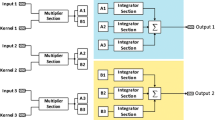Abstract
A common goal in computer vision is to segment scenes into different objects sharing common properties such as depth, motion, or image intensity. A segmentation algorithm has been developed utilizing an absolute-value smoothness penalty instead of the more common quadratic regularizer. This functional imposes a piece-wide constant constraint on the segmented data. Since the minimized energy is guaranteed to be convex, there are no problems with local minima, and no complex continuation methods are necessary to find the unique global minimum. This is in sharp contrast to previous software and hardware solutions to this problem. The energy minimized can be interpreted as the generalized power (or co-content) of a nonlinear resistive network. The network is called thetiny-tanh network since the I-V characteristic of the nonlinear resistor must be an extremely narrow-width hyperbolic-tangent function. This network has been demonstrated for 1-D step-edges with analog CMOS hardware and for a 2-D stereo algorithm in simulations.
Similar content being viewed by others
References
M. Bertero, T. Poggio, and V. Torre, Ill-posed problems in early vision,Proc. IEEE, 76:869–889, 1988.
J. Besag, Towards Bayesian image analysis,J. Appl. Stat. 16(3):395–407, 1989.
A. Black and A. Zisserman,Visual Reconstruction. MIT Press: Cambridge, MA, 1987.
L.O. Chua, C.A. Desoer, and E.S. Kuh,Linear and Nonlinear Circuits. McGraw-Hill: New York, 1987.
D. Geman and G. Reynolds, Constrained restoration and the recovery of discontinuities,IEEE Trans. Patt. Anal. Mach. Intell. 14(3):367–383, 1992.
S. Geman and D. Geman, Stochastic relaxation, Gibbs distribution and the Bayesian restoration of images,IEEE Trans. Patt. Anal. Mach. Intell. 6:721–741, 1984.
P.E. Gill, W. Murray, and M.H. Wright,Practical Optimization. Academic Press: San Diego, CA, 1981.
F. Girosi, Models of noise and robust estimates, A.I. Memo 1287, MIT AI Lab, 1991.
P.J. Green, Bayesian reconstruction from emission tomograph data using a modified EM algorithm,IEEE Trans. Med. Imag. 9:84–93, 1990.
F.R. Hampel, P.J. Rousseeuw, E.M. Ronchetti, and W.A. Stahel,Robust statistics: the approach based on influence functions. MIT Press: Cambridge, MA, 1986.
J.G. Harris, C. Koch, and J. Luo, A two-dimensional analog VLSI circuit for detecting discontinuities in early vision,Science 248:1209–1211, 1990.
J.G. Harris, C. Koch, J. Luo, and J. Wyatt, Resistive fuses: analog hardware for detecting discontinuities in early vision. In C. Mead and M. Ismail, eds.,Analog VLSI Implementations of Neural Systems, Kluwer: Norwell, MA, 1989.
J.G. Harris, Analog models for early vision, PhD thesis, California Institute of Technology, Pasadena, CA, Dept. of Computation and Neural Systems, 1991.
J.G. Harris, S.C. Liu, and B. Mathur, Discarding outliers in a nonlinear resistive network,Proc. Intern. Joint Conf. Neural Networks, pp. 501–506, Seattle, WA, July 1991.
B.K.P. Horn, Determining lightness from an image,Comput. Graph. Image Process. 3(1):277–299, December 1974.
B.K.P. Horn, Parallel networks for machine vision, Tech. rept., MIT Artificial Intelligence Laboratory, Cambridge, MA, 1988. AI Memo No. 1071.
P.J. Huber,Robust Statistics. Wiley: New York, 1981.
W.J. Karplus,Solution of Field Problems. McGraw-Hill: New York, 1958.
C. Koch, Seeing chips: analog VLSI circuits for computer vision,Neural Computation 1:184–200, 1989.
C. Koch, J. Luo, and C. Mead, Optical flow and surface interpolation in resistive networks: algorithms and analog VLSI chips. In B. Shriver, ed.,Neural Networks. IEEE Computer Science Press: Washington, DC, 1990.
C. Koch, J. Marroquin, and A. Yuille, Analog “neuronal” networks in early vision,Proc. Natl. Acad. Sci. B., 83:4263–4267, 1987.
J. Lazzaro and C.A. Mead, A silicon model of auditory localization,Neural Computation 1:47–57, 2989.
M. Levine,Methods for Solving Engineering Problems Using Analog Computers. McGraw-Hill: New York, 1964.
J.J. Little, H.H. Bülthoff, and T. Poggio, Parallel optical flow using local voting,IEEE Proceed. 2nd Intern. Conf. Comput. Vis., Tarpon Springs, FL, December 1988.
A. Lumsdaine and J.L. Wyatt, Jr., Nonlinear analog networks for image smoothing and segmentation,J. VLSI Sig. Process. 1991. To appear.
J. Luo, C. Koch, and C. Mead, An experimental subthreshold, analog CMOS two-dimensional surface interpolation circuit, Neural Information Processing Systems Conference, Denver, CO, November 1989.
R.F. Lyon and C.A. Mead, An analog electronic cochlea,IEEE Trans. Acoust., Speech, Sig. Process. 36:1119–1134, 1988.
J. Marroquin, S. Mitter, and T. Poggio, Probabilistic solution of ill-posed problems in computational vision,J. Am. Stat. Assoc 82:76–89, 1987.
C. Mead,Analog VLSI and Neural Systems. Addison-Wesley: Reading, MA 1989.
C.A. Mead and M.A. Mahowald, A silicon model of early visual processing,Neural Networks. 1:91–97, 1988.
W. Millar, Some general theorems for nonlinear systems possessing resistance,Philosophical Magazine 42:1150–1160, 1951.
J. Platt, Constraint methods for neural networks and computer graphics, Dept. of Computer Science Technical Report Caltech-CS-TR-89-07, California Institute of Technology, Pasadena, CA, 1990.
T. Poggio and C. Koch, An analog model of computation for the ill-posed problems of early vision, Technical report, MIT Artificial Intelligence Laboratory, Cambridge, MA, 1984. AI Memo No. 783.
T. Poggio and C. Koch, Ill-posed problems in early vision: from computational theory to analogue networks,Proc. Roy. Soc. (London)B, 226:303–323, 1985.
T. Poggio, V. Torre, and C. Koch, Computational vision and regularization theory,Nature 317:314–319, September 1985.
B.G. Schunck, Robust computational vision,Proc. Robust Methods in Computer Vision Workshop, 1989.
D. Shulman and J. Hervé, Regularization of discontinuous flow fields,Proc. IEEE Workshop on Visual Motion, pp. 81–86, 1989.
M.A. Sivilotti, M.A. Mahowald, and C.A. Mead, Real-time visual computation using analog CMOS processing arrays. In1987 Stanford Conference on Very Large Scale Integration, MIT Press: Cambridge, MA, 1987.
Author information
Authors and Affiliations
Rights and permissions
About this article
Cite this article
Harris, J.G. An analog network for continuous-time segmentation. Int J Comput Vision 10, 43–51 (1993). https://doi.org/10.1007/BF01440846
Received:
Issue Date:
DOI: https://doi.org/10.1007/BF01440846




